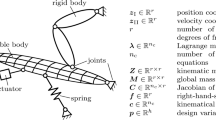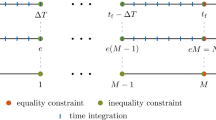Abstract
With the complexity and large dimensionality of many modern multibody dynamic applications, the efficiency of the sensitivity evaluation methods used can greatly impact the overall computation cost and as such can greatly limit the usefulness of the sensitivity information. Most current direct differentiation approaches suffer from prohibitive computational cost, which may be as great as O(n4+n2m2+nm3) (for systems with n generalized coordinates and m algebraic constraints). This paper presents a concise and computationally efficient sensitivity analysis scheme to facilitate such sensitivity calculations. A unique feature of this scheme is its use of recursive procedures to directly embed the algebraic constraint relations in forming and simultaneously solving a minimal set of equations. This results in far fewer operations than more traditional, or so-called O(n), counterparts. The algorithm determines the derivatives of generalized accelerations in O(n+m) operations overall. The resulting equations are “exact” to integration accuracy and enforce constraints exactly at both the velocity and acceleration levels.
Similar content being viewed by others
References
Anderson, K.S. 1990: Recursive Derivation of Explicit Equations of Motion for Efficient Dynamic/Control Simulation of Large Multibody Systems, Ph.D. Dissertation, Stanford University, CA
Anderson, K.S. 1992: An order-n formulation for motion simulation of general constrained multi-rigid-body systems. Computers and Structures 43(3), 565–572
Anderson, K.S. 2001: Improved order-n Performance Algorithm for the Simulation of Constrained Multi-Rigid-Body Dynamic Systems. Proceedings ASME Design Engineering Technical Conference (DETC 2001), Pittsburgh Sept. 9–13, 2001. Paper DETC2001/VIB-21334
Anderson, K.S.; Critchley, J.H. 2003: Improved Order-n Performance Algorithm for the Simulation of Constrained Multi-Rigid-Body Systems. Multibody System Dynamics 9, 185–212
Barthelemy, J.-F.M.; Hall, L.E. 1995: Automatic differentiation as a tool in engineering design. Structural Optimization 9, 76–82
Bestle, D.; Eberhard, P. 1992: Analyzing and optimizing multibody systems. Mechanics of Structures and Machines 20(1), 67–92
Bestle, D.; Seybold, J. 1992: Sensitivity analysis of constrained multibody systems. Archive of Applied Mechanics 62, 181–190
Bischof, C.H. 1996: On the automatic differentiation of computer programs and an application to multibody systems. IUTAM Symposium on Optimization of Mechanical Systems, Kluwer Academic, pp. 41–48
Chang, C.O.; Nikravesh, P.E. 1985: Optimal design of mechanical systems with constraint violation stabilization method. Journal of Mechanisms, Transmissions, and Automation in Design 107, 493–498
Dias, J.M.P.; Pereira, M.S. 1997: Sensitivity analysis of rigid-flexible multibody systems. Multibody System Dynamics 1(3), 303–322
Eberhard, P. 1996: Adjoint variable method for sensitivity analysis of multibody systems interpreted as a continuous, hybrid form of automatic differentiation. Proceedings of the 2nd International Workshop on Computational Differentiation, Santa Fe, NM, USA, 12–14 Feb, pp. 319–328
Featherstone, R. 1983: The calculation of robot dynamics using articulated-body inertias. International Journal of Robotics Research 2(1), 13–30
Hollerbach, J.M. 1980: A recursive lagrangian formulation of manipulator dynamics and a comparative study of dynamics formulation complexity. IEEE Transaction on Systems, Man, and Cybernetics SMC-10(11), 730–736
Haug, E.J.; Arora, J.S. 1979: Applied Optimal Design. New York: John Wiley & Sons, Inc.
Haug, E.J.; Wehage, R.A.; Mani, N.K. 1984: Design sensitivity analysis of large-scaled constrained dynamic mechanical systems. Transactions of the ASME 106, 156–162
Hsu, Y. 2001: Order-n Analytic Sensitivity Analysis for Multibody Dynamic Systems Optimization. Ph.D. Dissertation Department of Mechanical Engineering, Aeronautical Engineering and Mechanics. Rensselaer Polytechnic Institute, Nov.
Hsu, Y.; Anderson, K.S. 2001: Low operational order analytic sensitivity analysis for tree-type multibody dynamic systems. Journal of Guidance, Control, and Dynamics 24(6), 1133–1143
Hsu, Y.; Anderson, K.S. 2002: Recursive Sensitivity Analysis for Constrained Multi-rigid-body Dynamic Systems Design Optimization. Structural and Multidisciplinary Optimization 24(4), 312–324
Jain, A.; Rodriguez, G. 1999: Sensitivity analysis for multibody systems using spatial operators. International Conference on Scientific Computation and Differential Equations (SciCADE’99), Aug., Fraser Island, Queensland, Australia.
Kane, T.R.; Levinson, D.A. 1985: Dynamics: Theory and Applications. New York: McGraw-Hill, Inc.
Pagalday, J.M.; Aranburu, I. 1996: Multibody dynamics optimization by direct differentiation methods using object oriented programming. IUTAM Symposium on Optimization of Mechanical Systems, Kluwer Academic, pp. 213–220
Pradhan, S.; Modi, V.J.; Misra, A.K. 1997: Order n formulation for flexible multibody systems in tree topology: lagrangian approach. Journal of Guidance, Control, and Dynamics 20(4), 665–672
Rosenthal, D.E. 1990: An order n formulation for robotic systems. Journal of Astronautical Sciences 38(4), 511–529
Schaechter, D.B.; Levinson, D.A.; Kane, T.R. 1997: AUTOLEV User’s Manual Version 3.2, Online Dynamics, Inc., Sunnyvale, CA
Serban, R.; Haug, E.J. 1998: Analytical derivatives for multibody system analyses. Mechanics of Structures and Machines 26(2), 145–173
Tak, T. 1990: A recursive approach to design sensitivity analysis of multibody systems using direct differentiation. Ph.D. Dissertation, The University of Iowa
Stejskal, V.; Valášek, M. 1996: Kinematics and Dynamics of Machinery. New York: Marcel Dekker, Inc.
Wehage, R.A.; Haug, E.J. 1982: Generalized coordinate partitioning for dimension reduction in analysis of constrained dynamic systems. Transaction of ASME, Journal of Machine Design 104, 247–255
Author information
Authors and Affiliations
Corresponding author
Rights and permissions
About this article
Cite this article
Anderson, K., Hsu, Y. Order-(n+m) direct differentiation determination of design sensitivity for constrained multibody dynamic systems. Struct Multidisc Optim 26, 171–182 (2004). https://doi.org/10.1007/s00158-003-0336-1
Received:
Revised:
Published:
Issue Date:
DOI: https://doi.org/10.1007/s00158-003-0336-1




